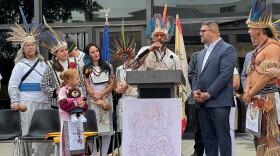Valle Hill is a neighborhood in Puerto Rico that shouldn’t exist.
Lea esta historia en español. / Read this story in Spanish.
It is a village of private homes on a public wetland. When it rains, it floods. Residents who have water or power probably have it illegally. Few if any residents here have title to their properties. And the water project that was to help the residents? It’s stalled, and so is the effort to build a dike to stop the floodwaters from rising again.
And then came Hurricane Maria, which only made a bad situation worse. Take it from Alberto Díaz. By the time his neighbors dragged him to safety, Maria’s flood waters were up to his chin. That was more than four months ago. Since then, the 68-year-old retired auto body worker has gutted most of his house, ripped out the carpets, and removed the furniture.
Outside his home is a small fleet of flooded, broken cars. He sleeps on a mattress in his outdoor patio. The metal roof keeps the rain away, he said. But not the mosquitos, roaches, or rats.
“No human being should live like this,” Díaz said.
And, if you ask elected officials, humans aren’t supposed to live in Valle Hill at all.
Built after Hurricane Hugo in 1989, Valle Hill is part of the larger neighborhood called San Isidro, which rests in the municipality of Canóvanas.
Many of its several hundred families are from the Dominican Republic, some without legal status; others came here years ago just looking for a cheaper a place to build a home; still more, like Díaz, moved here without knowing what they were getting into.
Some officials have said the residents invaded the public land; some residents say they were invited and encouraged to move there by the city’s former mayor. But that’s all history now. Invaded or invited, the reality is that Díaz and his neighbors in Valle Hill live on a public wetland.
Díaz says he remembers when he moved her nearly 20 years ago. He bought the land off a friend, site unseen. But when he arrived,“I realized [what] I had bought was a puddle of water,” he said.

Javier Aponte is a member of Puerto Rico’s house of representatives.
”Nobody has title here,” he said, on a recent visit to the neighborhood to deliver a portable water purifier. Without title to their property, Aponte said, residents like Díaz who lost their homes can’t get federal help to rebuild them.
“If you don’t have title,” he said, “you don’t have anything.”
A FEMA spokesman said that there are programs that residents can use to get some federal help to pay rent, cover essential needs, and find loans, among other things. But that may be all.
The area has long been under the eye of the federal government.
After years of review and enforcement, the federal Environmental Protection Agency decided in 2015 that the environmental problem was largely resolved. But Paloma Ortiz said the humanitarian one remains.
“There’s a public health problem here, more than just people with pink eye and people in bed,” said Ortiz, a 24-year-old volunteer nurse from San Juan. “The medical conditions are coming from the public health problem.”


Ortiz first came here with a church group to help distribute food and clothing after the storm. But she says she quickly realized that the neighborhood needed more.
Once or twice a week, she volunteers her time to come here to check in on the elderly and the infirmed. When we visited, she cleaned and dressed a painful ulcer on the foot of a bedridden man, she consulted with a woman who had an abdominal hernia, and she checked in with Alberto Díaz -- the man who sleeps on his outdoor patio.
“We’re fighting,” she said, only half-joking as she and Díaz were in his house looking over his medications. She thinks he doesn’t take the medicines he needs to, and -- in a caring way – she let him know it. For his part, Díaz said he doesn’t like taking the pills; there are so many it’s almost like a full meal. But, living mostly alone, he said appreciates the help.
“She is like an angel come down from heaven,” he said, before giving her a kiss on the cheek.

Janet Lozada used to have a house next door to Díaz’s, but Maria destroyed it. She’s lived here for 19 years -- she moved here when she was pregnant and looking for a place to call home.
Now, she’s mad -- fed up with the conditions in which she and her neighbors live. Some of them are Puerto Rican, others are Dominicans here without legal status. But all of them, she said, are human beings.
“Human beings live here,” she said. “It’s not fair what is happening here.”

We met Lozada when the governors of both Puerto Rico and New York were to be in Valle Hill to talk about hurricane relief. Walking to the press conference, Lozada said she wanted to understand this: What good does it do to have a few thousand dollars from FEMA for a stove, if she doesn’t have anywhere to put it?
After the press conference, we asked Gov. Ricardo Rosselló for an update on what will happen with the residents of Valle Hill.
“Of course, the mayor has been working on the dike so they can also have their land properties passed to them,” he said. “And our commitment is, once that is set up by the federal government, we would give those families the access to their land.”
But according to the mayor of the town the dike plan needs $50 million from Congress to move forward, and it’s stalled.





